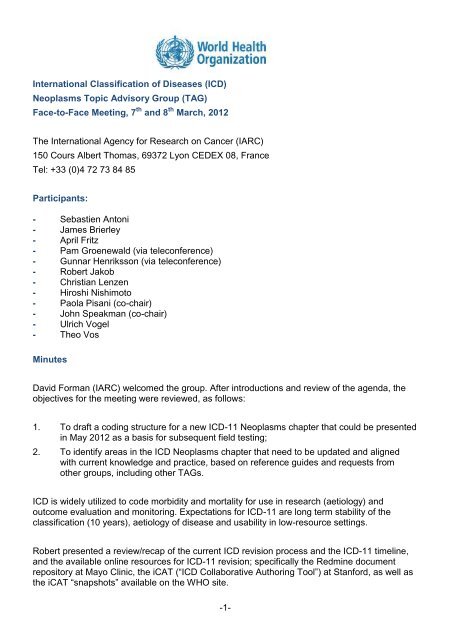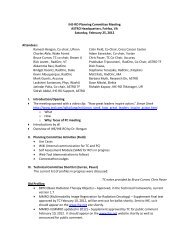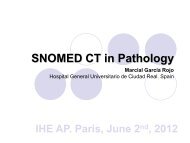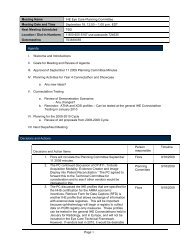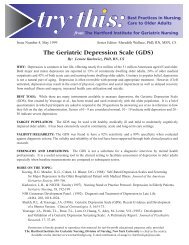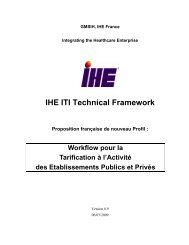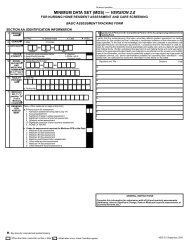International Classification of Diseases (ICD) - IHE Wiki
International Classification of Diseases (ICD) - IHE Wiki
International Classification of Diseases (ICD) - IHE Wiki
Create successful ePaper yourself
Turn your PDF publications into a flip-book with our unique Google optimized e-Paper software.
System DesignProjekt: SprichWortReferenznummer: 143376-LLP-1-2008-1-SI-KA2-KA2MPVerantwortlicher Partner: IICM, TU GrazLeiter: Univ. Doz. Dr. DI Denis Helic
Option 1: E 1 D 2 1 3 .E 4 E 5 Option 2A: E 1 D 2 D 3 .E 4 E 5 Option 2B: E 1 D 2 D 3 .E 4 E 5“Behaviour”/stage:“Behaviour”/ stage/recurrence:“Behaviour”/ stage/recurrence:0: Benign1: Borderline2: In situ / Stage 03: Invasive, stage NOS4: Invasive Stage I5: Invasive Stage II6: Secondary Stage III7: Secondary Stage IV8: Systemic9: Unknown, unspec, notapp0: Benign1: Borderline2: In situ / Stage 03:Invasive, stage NOS4: Invasive Stage I5: Invasive Stage II6: Secondary Stage III7: Secondary Stage IV8: Systemic9: Unknown, unspec, notappA: Remission/Free <strong>of</strong>diseaseB: Local disease(recurrence/persistent)C: regional disease(recurrence persistent)D: distant disease(recurrence/persistent)E: local and regionalF: local and distantG: regional and distantH: local, regional, anddistant0: Benign1: Borderline2: In situ / Stage 03: Invasive, stage NOS4: Invasive Stage I5: Invasive Stage II6: Secondary Stage III7: Secondary Stage IV8: Systemic9: Unknown, unspec, notappA: Remission/Free <strong>of</strong>diseaseB: Persistent diseaseC: rStageID: rStageIIE: rStageIIIF: rStageIVThe proposed arrangement would facilitate routine case-finding/clinical follow-up. It alsomoves “behaviour” within anatomy rather than the reverse as in <strong>ICD</strong>-10; all “behaviours” havethe same degree <strong>of</strong> topographic detail.Char 4:Organ subsite: As in <strong>ICD</strong>-10, plus alignment with T definition (see oral cavity/pharynx) <strong>of</strong> TNM.Needs systematic examination <strong>of</strong> every site and comparison with TNM.Char 5 (pending evaluation by Hematology TAG):Morphology groups: the major ones defined in <strong>ICD</strong>-O for solid tumors and utilized as aninternational rule to define multiple primary tumours within a patient, with the addition <strong>of</strong>- 7 -
melanoma (any site). Groups ‘lymphomas’ and ‘leukaemia’ are replaced with 12-15 entitiesfrom the new WHOBB classification <strong>of</strong> haematopoietic and lymphoid tissues (pending details <strong>of</strong>‘NOS’ groups to be defined):Morphology groups- 8 -<strong>ICD</strong>-O M codes1 Squamous carcinomas M 805 - 808, M-812 - 8132 Basal cell carcinomas M-809 – 8113 Adenocarcinomas M 814, M 816, M 819 - 822, M 826- 833, M-835 - 855, M 857, M 8944 Other specific carcinomas M 803 804, M 815, M 817 - 818,M-823, M 824, M-825, M-834, M856, M 858 - 8675 Unspecified carcinomas (NOS) M 801, M 8026 Sarcomas and s<strong>of</strong>t tissue tumors M 868 - 871, M 880 - 892, M 899,M 904, M 912 - 913, M 915 - 925,M 937, M 954 - 9587 Kaposi’s sarcoma M-9148 Mesothelioma M-9059 Melanoma M 872 – 879AMyeloproliferative neoplasms including abnormalities<strong>of</strong> PDGFRA, PDGFRB OR FGFR1 (first two groupsin WHOBB)Pending mapping <strong>of</strong> <strong>ICD</strong>-O McodesC Myelodisplastic/myeloproliferative neoplasms Pending mapping <strong>of</strong> <strong>ICD</strong>-O McodesD Myelodysplastic syndromes Pending mapping <strong>of</strong> <strong>ICD</strong>-O McodesE Acute myeloid leukaemia (AML) Pending mapping <strong>of</strong> <strong>ICD</strong>-O McodesF Acute leukaemias <strong>of</strong> ambiguous lineage Pending mapping <strong>of</strong> <strong>ICD</strong>-O McodesG Precursor lymphoid neoplasms Pending mapping <strong>of</strong> <strong>ICD</strong>-O McodesH Mature B-cell neoplasms Pending mapping <strong>of</strong> <strong>ICD</strong>-O McodesJ Mature T-cell and NL-cell neoplasms Pending mapping <strong>of</strong> <strong>ICD</strong>-O McodesK Hodgkin lymphoma Pending mapping <strong>of</strong> <strong>ICD</strong>-O McodesL Histiocytic and dendritic cell neoplasms Pending mapping <strong>of</strong> <strong>ICD</strong>-O McodesM Post-transplant lymphoproliferative disorders, PTLDNOSPending mapping <strong>of</strong> <strong>ICD</strong>-O McodesS Unspecified cell lineage Pending mapping <strong>of</strong> <strong>ICD</strong>-O M
codesT Unclassifiable/undetermined Pending: define NOS entities bycell lineage/diagnostic degree <strong>of</strong>investigationW Other specified types <strong>of</strong> cancer M 893, M 895 - 898, M 900 - 903,M 906 - 911, M 926 - 936, M 938 -953, M 973 - 975, M-976Z Unspecified types <strong>of</strong> cancer M 800, M-997If there is the option <strong>of</strong> a further digit (but the TAG does not feel strongly about this):Char 6: Histopathologic grade- 9 -
specified. The values 1-X are reserved for indicating that additional information is coded, andindicating a simple grammar for linking related clusters <strong>of</strong> coded information.g. The inclusion <strong>of</strong> a forced number (1 3 ) is to preclude spelling possible “4-letter words”literally, in any language.h. The requirement that the second digit D 2 be alpha, is to ensure visual distinction <strong>of</strong><strong>ICD</strong>11 linearization codes from <strong>ICD</strong>10 codes.2. It is desirable that various linearizations should share a common code base, if possible,(i.e. , the first three digits <strong>of</strong> the code: e.g., ED1. section <strong>of</strong> the code) which indicates the samegroup <strong>of</strong> concepts. This way <strong>of</strong> coding is referred to as STYLE 1 (aka “the Russian doll model”)which allows telescopically nested linearizations for mortality, morbidity, primary care, verbalautopsy, and some short lists. The purpose <strong>of</strong> STYLE 1 is to facilitate the understanding <strong>of</strong> thecorrespondence among different linearizations and uses <strong>of</strong> <strong>ICD</strong>, within certain bounds.3. In STYLE 2, different linearizations use different codes to represent similar-but-notidentical-concepts.For example, Myocardial Infarction in Verbal Autopsy is not exactly thesame concept in the Morbidity Linearization. Linking similar concepts across varyinglinearizations will be done through the Foundation Layer via their corresponding identifiers.The equivalence <strong>of</strong> two concepts is created computationally through <strong>of</strong> Code-Coderelationships across linearizations.a. In STYLE 2 distinguishing among various <strong>ICD</strong> linearizations would be done using 2-letter prefix codes, (e.g. PC- Primary Care; VA- Verbal Autopsy etc.).4. It is recognized that some linearizations would, however, have a totally different codingscheme and post-coordination, as is currently the case for External Causes and Injury chapter.5. <strong>ICD</strong> Foundation Component – Linearization system will allow representation <strong>of</strong>alternative structures, for example emulation <strong>of</strong> the US <strong>ICD</strong>-10-CM, e.g. A11.1111 where Acorresponds to the base 26 Alpha characters (A-Z). This would be an exception that wouldrequire the use <strong>of</strong> a prefix.Approval status:DEADLINE: 15 February 2012RSG SEG DECISION: to be ApprovedWHO DECISION: to be ApprovedNote: major changes in this version include:a) The truncation <strong>of</strong> digits from seven to five, recognizing that a multi-dimensional codingspace will, by design, require a smaller coding space.b) Forcing the second digit to be alphac) Clarifying that inheritance is a property <strong>of</strong> the Foundation Layer and can be visuallyrendered, though linearizations will attempt some reasonable inheritance where practical.d) Introduction <strong>of</strong> a new set <strong>of</strong> residual categories (1-X), which form clustering grammarsfor linking multidimensional codes.e) Acknowledging Z codes are a reserved set for modifier- 11 -
-12-ANNEX 2


